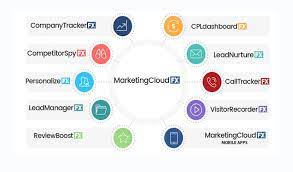The Power of Media Marketing in Today’s Digital Landscape
In the fast-paced world of digital marketing, media marketing plays a crucial role in helping businesses connect with their target audience and drive engagement. With the rise of social media platforms, online streaming services, and digital advertising channels, the opportunities for brands to reach consumers have never been greater.
Understanding Media Marketing
Media marketing encompasses a wide range of strategies aimed at promoting products or services through various forms of media. This includes traditional channels such as television, radio, print publications, as well as digital platforms like social media, websites, and online videos.
The Impact of Social Media
Social media has revolutionised the way businesses interact with their audience. Platforms like Facebook, Instagram, Twitter, and LinkedIn offer a direct line of communication between brands and consumers. By creating engaging content, participating in conversations, and running targeted advertising campaigns, businesses can build brand awareness and foster customer loyalty.
Video Marketing
Video content continues to dominate the digital landscape. From short clips on TikTok to long-form tutorials on YouTube, video marketing allows brands to convey their message in a compelling and visually appealing way. With the increasing popularity of live streaming and interactive video formats, businesses have more opportunities than ever to engage with their audience in real-time.
The Future of Media Marketing
As technology continues to evolve, so too will the landscape of media marketing. Artificial intelligence (AI), virtual reality (VR), and augmented reality (AR) are poised to transform how brands create and deliver content to consumers. Personalisation, interactivity, and immersive experiences will be key drivers in shaping the future of media marketing strategies.
By embracing the power of media marketing and staying ahead of industry trends, businesses can position themselves for success in an increasingly competitive digital marketplace.
Nine Key Advantages of Media Marketing for Boosting Brand Success
- 1. Increased brand visibility and recognition.
- 2. Targeted reach to specific demographics and audiences.
- 3. Enhanced engagement through interactive content.
- 4. Cost-effective compared to traditional advertising methods.
- 5. Real-time feedback and analytics for performance tracking.
- 6. Ability to create viral content for organic growth.
- 7. Builds credibility and trust with consumers through storytelling.
- 8. Enables direct communication with customers for feedback and support.
- 9. Adaptable to evolving trends in technology and consumer behaviour.
Challenges in Media Marketing: Navigating Saturation, Ad Blindness, and Rising Costs
1. Increased brand visibility and recognition.
In the realm of media marketing, one significant advantage is the heightened brand visibility and recognition it offers. By strategically utilising various media channels such as social media, online advertising, and traditional platforms, businesses can amplify their presence and reach a wider audience. Consistent exposure through targeted campaigns helps to establish brand recall among consumers, fostering trust and loyalty towards the brand. Ultimately, increased brand visibility and recognition lead to enhanced market positioning and a competitive edge in the ever-evolving digital landscape.
2. Targeted reach to specific demographics and audiences.
One significant advantage of media marketing is its ability to achieve targeted reach to specific demographics and audiences. By utilising data analytics and audience segmentation tools, businesses can tailor their marketing messages to resonate with the right people at the right time. This targeted approach not only increases the likelihood of engaging with potential customers but also enhances the overall effectiveness of marketing campaigns by delivering relevant content that speaks directly to the interests and preferences of specific demographic groups.
3. Enhanced engagement through interactive content.
Enhanced engagement through interactive content is a significant advantage of media marketing. By creating interactive experiences such as quizzes, polls, games, and live streams, businesses can captivate their audience and encourage active participation. Interactive content not only entertains but also educates and builds a stronger connection with consumers. This two-way communication fosters deeper engagement, increases brand loyalty, and ultimately leads to higher conversion rates. In today’s digital landscape, where attention spans are short and competition is fierce, leveraging interactive content in media marketing can set a brand apart and create memorable experiences that resonate with the target audience.
4. Cost-effective compared to traditional advertising methods.
Media marketing offers a significant advantage in terms of cost-effectiveness when compared to traditional advertising methods. By leveraging digital platforms and targeted strategies, businesses can reach their desired audience at a fraction of the cost of traditional media channels such as television or print. This affordability allows companies of all sizes to allocate their marketing budgets more efficiently and achieve a higher return on investment, making media marketing a practical and sustainable choice for reaching and engaging with consumers in today’s competitive market.
5. Real-time feedback and analytics for performance tracking.
Real-time feedback and analytics for performance tracking is a significant advantage of media marketing. By leveraging data-driven insights and monitoring engagement metrics in real-time, businesses can quickly assess the effectiveness of their marketing campaigns. This allows for prompt adjustments and optimisations to improve campaign performance, maximise ROI, and better understand consumer behaviour. The ability to track key performance indicators in real-time provides valuable insights that empower businesses to make informed decisions and continuously refine their media marketing strategies for optimal results.
6. Ability to create viral content for organic growth.
The ability to create viral content for organic growth is a significant advantage of media marketing. When a piece of content goes viral, it has the potential to reach a vast audience quickly and generate widespread engagement. Viral content can spark conversations, increase brand visibility, and drive organic traffic to a company’s website or social media channels. By tapping into the power of viral marketing, businesses can amplify their reach and connect with new audiences in a cost-effective and impactful way.
7. Builds credibility and trust with consumers through storytelling.
Media marketing excels in building credibility and trust with consumers by leveraging the art of storytelling. By crafting compelling narratives that resonate with their audience, brands can establish a genuine connection that goes beyond mere advertising. Through storytelling, businesses can humanise their brand, showcase their values and mission, and evoke emotions that foster trust and loyalty among consumers. This approach not only helps in creating a memorable brand identity but also strengthens the bond between the brand and its audience, ultimately leading to long-lasting relationships built on authenticity and transparency.
8. Enables direct communication with customers for feedback and support.
Media marketing enables direct communication with customers, allowing businesses to gather valuable feedback and provide timely support. Through social media platforms, email campaigns, and online chat services, brands can engage with their audience in real-time, addressing concerns, answering queries, and building stronger relationships. This direct line of communication not only fosters customer loyalty but also provides insights that can help businesses improve their products or services based on customer feedback.
9. Adaptable to evolving trends in technology and consumer behaviour.
One of the significant advantages of media marketing is its adaptability to evolving trends in technology and consumer behaviour. In an ever-changing digital landscape, businesses must remain agile to stay relevant and competitive. Media marketing allows brands to swiftly adjust their strategies in response to new technological advancements and shifts in consumer preferences. Whether it’s leveraging the latest social media platforms, adopting AI-driven analytics for better targeting, or creating content that aligns with emerging cultural trends, media marketing provides the flexibility needed to engage audiences effectively. This adaptability ensures that brands can maintain a strong connection with their consumers, fostering loyalty and driving growth in a dynamic market environment.
1. Saturation
In the realm of media marketing, one significant drawback is the issue of saturation. The sheer volume of content and advertisements bombarding consumers across multiple media channels can pose a formidable challenge for businesses aiming to distinguish themselves and attract the attention of their desired audience. In such a crowded landscape, breaking through the noise and making a lasting impact becomes increasingly difficult, requiring strategic planning and innovative approaches to cut through the clutter and engage effectively with consumers.
2. Ad Blindness
In today’s digital age, one significant downside of media marketing is ad blindness. As consumers are exposed to a constant barrage of advertisements across various platforms, they have developed a remarkable ability to tune out or actively avoid traditional advertising methods. This phenomenon results in a reduced effectiveness of some media marketing strategies, as brands struggle to capture the attention of their target audience amidst the overwhelming volume of promotional content. Marketers must adapt by finding innovative ways to engage consumers authentically and meaningfully to combat ad blindness and ensure their message resonates with their audience.
3. Cost
One notable drawback of media marketing is the substantial cost involved in implementing comprehensive campaigns, particularly on popular platforms. Businesses aiming to reach a wider audience and compete effectively in the digital landscape often face the challenge of allocating significant financial resources towards advertising and promotion. Despite the substantial investment, there is no guarantee that the desired results, such as increased brand awareness or higher conversion rates, will be achieved. This financial risk associated with media marketing expenditure underscores the importance of strategic planning and careful evaluation of return on investment to ensure cost-effectiveness and optimal outcomes for businesses.




